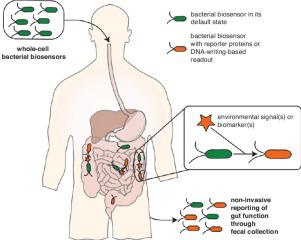Current Opinion in Microbiology ( IF 5.9 ) Pub Date : 2020-08-19 , DOI: 10.1016/j.mib.2020.07.014 Tanmay Tanna 1 , Raghavendra Ramachanderan 2 , Randall J Platt 3

|
Advances in synthetic biology and microbiology have enabled the creation of engineered bacteria which can sense and report on intracellular and extracellular signals. When deployed in vivo these whole-cell bacterial biosensors can act as sentinels to monitor biomolecules of interest in human health and disease settings. This is particularly interesting in the context of the gut microbiota, which interacts extensively with the human host throughout time and transit of the gut and can be accessed from feces without requiring invasive collection. Leveraging rational engineering approaches for genetic circuits as well as an expanding catalog of disease-associated biomarkers, bacterial biosensors can act as non-invasive and easy-to-monitor reporters of the gut. Here, we summarize recent engineering approaches applied in vivo in animal models and then highlight promising technologies for designing the next generation of bacterial biosensors.
中文翻译:

报告肠道功能的工程细菌:技术和实施。
合成生物学和微生物学的进步使得能够创造能够感知和报告细胞内和细胞外信号的工程细菌成为可能。在体内部署时这些全细胞细菌生物传感器可以作为监测人类健康和疾病环境中感兴趣的生物分子的哨兵。这在肠道微生物群的背景下特别有趣,肠道微生物群在整个时间和肠道运输过程中与人类宿主广泛相互作用,并且可以从粪便中获取而无需侵入性收集。利用遗传回路的合理工程方法以及不断扩大的疾病相关生物标志物目录,细菌生物传感器可以充当非侵入性且易于监测的肠道报告器。在这里,我们总结了最近在动物模型中应用于体内的工程方法,然后重点介绍了用于设计下一代细菌生物传感器的有前途的技术。











































 京公网安备 11010802027423号
京公网安备 11010802027423号